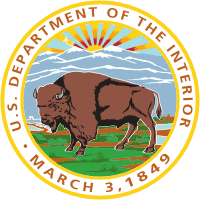United States Department of the Interior
|
|
 Larger version | |
| Established: | March 3, 1849 |
| Activated: | March 8, 1849 |
| Secretary: | Gale Norton |
| Deputy Secretary: | Vacant |
| Budget: | $10.7 billion (2004) |
| Employees: | 71,436 (2004) |
The United States Department of the Interior (DOI) is a Cabinet department of the United States government that manages and conserves most federally-owned land. These responsibilities are quite different than Interior Departments of other nations, which tend to focus on police or security. The U.S. Department of the Interior is not responsible for local government or for civil administration except in the cases of Indian reservations.
It is administered by the United States Secretary of the Interior, who by tradition generally comes from a Western state.
| Contents |
History
A department for domestic concerns was first considered by the First Congress in 1789, but those duties were placed in the Department of State. Its proposal continued to percolate for a half-century and was supported by Presidents from James Madison to James K. Polk. The 1846-48 Mexican-American War gave the proposal new steam as the responsibilities of the federal government grew. President Polk's Secretary of the Treasury, Robert J. Walker became a vocal champion of creating the new department.
In 1848, Walker stated in his annual report that several federal offices were placed in departments with which they had little to do. He noted that General Land Office had little to do with the Department of the Treasury. He also highlighted the Indian Affairs office in the Department of War and the Patent Office in the State Department. He argued that all should be brought together in a new Department of the Interior. A bill authorizing its creation passed the House of Representatives on February 15, 1849, and spent just over two weeks in the Senate.
The Department was established on March 3, 1849, the eve of President Zachary Taylor's inauguration, when the Senate voted 31 to 25 to create the Department. Its passage was delayed by Congressional Democrats who were reluctant to create more patronage opportunities for the incoming Whig administration.
Many of the domestic concerns the Department originally dealt with were gradually transferred to other Departments. Other agencies became separate Departments, such as the Bureau of Agriculture, which later became the Department of Agriculture. However, land and natural resource management, Native American affairs, wildlife conservation, and territorial affairs remain the responsibilities of the Department of the Interior
As of mid-2004, the Department managed 507 million acres (2,050,000 km²) of surface land, or about one-fifth of the land in the United States. It manages 476 dams and 348 reservoirs through the Bureau of Reclamation, 388 national parks, monuments, seashore sites, battlefields, etc. through the National Park Service, and 544 national wildlife refuges through the Fish and Wildlife Service. Energy projects on federally managed lands and offshore areas supply about 28 percent of the nation's energy production.
Operating units
- National Park Service
- U.S. Fish and Wildlife Service
- Bureau of Indian Affairs
- Bureau of Land Management
- Minerals Management Service
- Office of Surface Mining, Reclamation, and Enforcement
- U.S. Geological Survey
- Bureau of Reclamation
- Office of Insular Affairs
Related topics
External links
- United States Department of the Interior Official Website (http://www.doi.gov/)
- The Department of Everything Else: Highlights of Interior History (http://www.cr.nps.gov/history/online_books/utley-mackintosh/index.htm)
| United States Federal Executive Departments | Missing image Flag_of_the_United_States.png Flag of the United States |
|---|---|
| State | Treasury | Defense | Justice | Interior | Agriculture | Commerce | Labor | Health and Human Services | Housing and Urban Development | Transportation | Energy | Education | Veterans Affairs | Homeland Security | |
